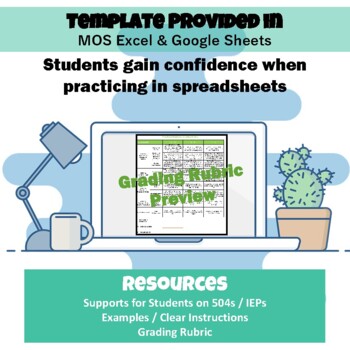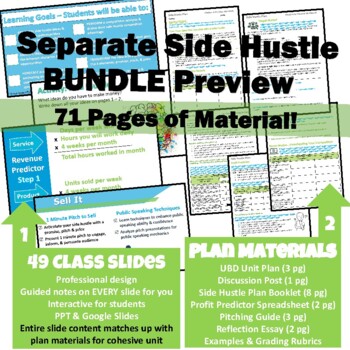Sales Forecast Profit Predictor Excel & Sheets Template - Accounting
- Zip
- Excel Spreadsheets
Description
Want to make business sales projections easier for students to understand and forecast? This Profit Predictor Template in Excel and Google Sheets has students practice predicting sales, calculating expenses, and determining profits using this simple napkin finance model in 4 easy-to-follow steps. A babysitting example makes it understandable along with detailed directions and a grading rubric providing clear expectations. Incorporate this versatile accounting template in any sales projection activity to build student spreadsheet confidence and entrepreneurial finance skills.
Great content related to courses in:
- Business & Entrepreneurship
- Accounting & Finance
- Business Technology, CTE, or vocational setting
Bring real world applications into the classroom to make learning FUN, RELEVANT, and MEANINGFUL. This can be incorporated into other units, projects or edited to meet your classroom needs. This is fully editable in Microsoft Excel and Google Sheets.
This lesson and activities:
- Promotes information understanding and retention
- Utilizes kinesthetic learning methods
- Diversifies teaching techniques
- Strengthens analysis skills
- Promotes higher level thinking
- Flexibility to use in various settings
**DO NOT PURCHASE IF YOU BOUGHT THE Side Hustle Project OR Side Hustle Bundle. This is modified version of what's included in that. **
GREAT COMPLIMENTARY UNIT THIS IS INCLUDED IN IS the SIDE HUSTLE BUNDLE for everything you need to deliver a comprehensive introductory lesson on side hustles - estimated time is 5 - 7 hours.
1. · UBD unit and lesson plan covering a comprehensive unit to introduce the concept of earning money with a side hustle, and then, take steps to ideate, research and plan a side hustle. Provides timeline for pacing and sequence.
2. Class Slides Presentation includes:
- Fully Ready Class Slides – 49 engaging slides (2 sets – Side Hustle & Pitching)
- PowerPoint & Google Slides – editable
- Teacher talking points on each slide, so you’re fully prepared with little preparation
- Interactive student activities to deepen learning through hands on learning
- Content coverage includes:
- Learning Objectives & State Frameworks
- Side Hustle Lesson: Definition, Benefits, Gig/Sharing Economy, High Potential Checklist, Opportunities & Obstacles, Competitive Analysis, Target Market, Profit Potential, and Pitching
3. Apply & Practice - PBL Project: Hands-on, creative 5 PART PROJECT with instructions, examples, grading rubrics, and resources for modifications / accommodations. Students ideate a side hustle, analyze their idea, perform a competitive analysis, predict sales / expenses / profits, and develop a pitch to convince the target market to buy. The 8 page Side Hustle Plan Ideation & Planning Booklet (use paper version or digitally) provides all the guidance needed and correlates with the class slides. The 2 page Profit Predictor spreadsheet helps develop student spreadsheet skills in Excel or Google Sheets. Project materials also include a Discussion Post & Reflection – an introductory discussion post and concluding reflection essay help to begin and end the project in meaningful ways.
Follow my Ms Biz TPT store to be notified of all my new products!
Let's get social. You'll be the first to hear about new product sales, ideas to use in the class, and get plugged into a valuable teacher community.
Facebook @Ms.Biz.2023
Instagram @MsBiz123
LinkedIn @Sharon Bogere
YouTube @msbiz-Teach_Business
-----------------------------------------------------------------------------
Some of my other great business products you may like:
- Super Bowl Economic Impact
- Student LinkedIn Account Project - Career Readiness with Presentation Slides featuring teacher talking points & interactive student activities
- Annual Holiday Scavenger Hunts Bundle
- Personal Branding Slides & Personal Business Card Project





